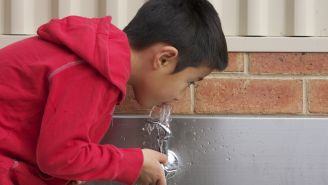Updated on November 26, 2024.
When you think of lead exposure in the home, your mind might go to old pipes. And indeed, lead pipes expose millions of Americans to this harmful heavy metal through the water we drink.
But aside from lead pipes, you may be surprised to learn there are several potential sources of lead we encounter every day. Most sources of lead won’t harm otherwise healthy adults. Children under the age of 6, however, are especially susceptible to lead exposure, says Melissa L. Gittinger, DO, a board-certified emergency physician and medical toxicologist at Grady Hospital and the Georgia Poison Center in Atlanta, Georgia.
Not only are young children more likely to be exposed to lead because they place so much of what they encounter in their mouths, but their developing brains and bodies are more vulnerable to the effects of lead poisoning.
Here are ways to identify some of the lesser-known sources of lead exposure in children’s spaces, as well as simple steps that parents, caregivers, and teachers can take to prevent childhood lead exposure. Plus, learn what to do if a child has already been exposed to lead.
Toys
The Consumer Product Safety Commission (CPSC), a government safety agency, bans the use of lead in many children’s products and toys. But recalls due to lead (and other harmful substances) still occur in the United States.
Certain loopholes allow lead into products that children use. For example, toys made before 1978 and those imported from other countries do not fall under lead protection laws. Even when lead protection laws are in place, they often aren’t strong enough to hold companies accountable for their practices.
Regulations have improved over time, but older toys may be decorated with lead-based paint, making them a harmful choice for any young child.
Here’s how to avoid lead in kids’ play areas:
Skip antique toys. Save older toys, including family hand-me-downs, until kids are old enough to avoid putting them in their mouths.
Remove any vinyl toys. Vinyl is often the main ingredient in soft, leathery-type plastic toys and some synthetic shoes. These can be legally sold containing certain amounts of lead because children aren’t expected to swallow or chew on them.
Shop age-appropriately. Only buy toys for your child’s age group. For example, toys for babies and infants have more stringent requirements because kids of this age are more likely to put items in their mouths.
Keep track of recalls. The CPSC website allows you to sign up to receive news of government toy recalls or to search recalls by company name.
For the youngest children, consider only purchasing toys that are made in the United States, Canada, or the European Union, or through online sources that help you figure out which brands are explicitly lead-free. Many countries have less stringent rules about lead and other harmful materials.
Play it safe. Toss out any metal or painted toys with unknown origins and be especially cautious of toys decorated with brightly colored dyes. These paints may contain lead. If you don’t know where a toy was manufactured or if you can’t find information on it via the CPSC website, play it safe and avoid playtime with it.
Keys and jewelry
Very small children love to put shiny things in their mouths. Metal jewelry and keys, however, pose serious risks to children’s health.
Jewelry can pose a serious risk for choking and lead poisoning. Items made outside the U.S. pose a greater risk due to differences in manufacturing standards. Likewise, different types of keys (such as those for cars, homes, and offices) often contain varying amounts of lead.
If you have babies or small children, don’t let them play with or chew on your keys or jewelry. Offer them safe, chewable toys instead. Also, be sure to keep souvenirs from global travels out of reach until your child is old enough to keep them out of their mouth.
Food, drinks, and water
There is no “safe” level of exposure to lead. Even so, lead manages to sneak into many realms of our daily lives, including our food and drinks.
Lead in food and drink
Lead was detected in 20 percent of baby food samples tested over 10 years in the Total Diet Study published by the U.S. Food and Drug Administration (FDA) in 2018.
Even fruit juice is not risk-free. In the FDA’s study, 89 percent of grape juice, 67 percent of mixed fruit juice, 55 percent of apple juice, and 45 percent of pear juice samples tested positive for lead. While exposures are common, they are not inevitable. Here’s what you can do to keep your little one safe:
- Look online or call your favorite food brands to see if they regularly test their products for lead.
- Avoid serving fruit juice to children younger than 1 year of age and serve it only rarely to older children.
- Opt for fresh fruits and vegetables whenever possible as these are less likely to contain lead. (Lead is more likely to enter the diet through processed foods.) When you do give your child prepared baby fruit and vegetables, contact the brand to ask about lead levels. It can also help to give your child a variety of different foods, to minimize exposure to lead from any one source.
Lead in tap water
It’s also important to be vigilant against lead in drinking water. Dr. Gittinger recommends using water filters specifically rated for lead removal. For help with shopping, the Environmental Working Group has published a guide to safe drinking water. If you can’t afford or access water filters, consider these steps to help ensure the safety of your water supply:
Flush your faucets. Run cold water for at least a minute for every 50 feet that your sink sits from the street before using it for drinking or cooking. That goes especially if your tap has not been used for six hours or more. Lead is more likely to leach into stagnant water.
Running faucets in this way can help flush your pipes and reduce the amount of lead and contaminants in the water. Note: Boiling water does not remove lead.
Get your water tested for lead. Water testing costs between $15 and $100 and can be done through state-certified drinking water laboratories.
If your child has an elevated blood lead level (more on this below), there are often state resources available to steer you to contractors who can help fix the problem. Contact your state health department or lead prevention programs in your state to ask about resources and support.
Dishware
Certain dishes and utensils may have been made using lead. This creates a risk because the process of heating can cause lead to leach into food. Older dishware may be especially troublesome, since the FDA didn’t regulate lead in dishes until the 1970s. Newer dishes are less likely to be a concern because manufacturers face increased scrutiny today and most retailers conform to California’s tough lead standard.
Even so, to be on the safe side, it helps to follow these tips:
Microwave and store food in glass rather than ceramic. Ceramic dishware may be problematic because some pottery and ceramicware manufactured in recent years may still use lead-containing glazes. Even items that don’t contain lead on their own may pick up lead residue when they are fired (or baked) in older kilns used to produce other items with lead-containing glazes. Further, the processes of heating and storing food in ceramic increases the risk that lead may leach into the food. This is particularly the case when acidic foods (like those made with tomatoes, citrus, or vinegar) are involved.
Opting for glass containers can help you avoid the potential risk of lead from ceramic items, as well as from plastic kitchenware. Plastic containers may contain potentially harmful chemicals such as BPA (or bisphenol A) and PFAS (or per- and polyfluoroalkyl substances).
Replace ceramic dishes that are chipped or cracked. Glaze that is fully intact can help prevent lead from leaching out of a ceramic item that contains lead. But if the glaze is cracked, chipped, or looks dusty or chalky after washing, the safest bet is to replace the dish. Additionally, avoid brightly colored glazes and homemade dishes (which could contain leaded glaze).
Search for lead-free dishware in stores. You can typically find this by looking for labels that say “lead-free.” If a label says, “Not safe for food, decorative use only,” that’s a strong hint the item contains lead.
Paint
One of the most common sources of childhood lead exposure is lead paint in homes and daycare centers built before 1978. Chips and dust from leaded paint can be a significant source of exposure, especially in areas like windowsills where children often have easy access. Smaller children may touch or even chew bits of peeled or crumbled paint.
Ideally, if older paint is chipping or crumbling or if your paint tests positive for lead, you would remove and replace it with the help of a lead-certified contractor.
“Don’t attempt renovations on your own,” Gittinger says. “Folks who don’t use lead-certified contractors or don’t learn how to do it themselves properly can actually make the problem worse and release a lot more lead, either through the daycare space or the home space.”
For people who cannot afford costly home renovations, there are other measures that may help:
Sweep up paint chips when you see them. Avoid vacuuming, which may kick lead dust into the air where it can be breathed.
Wipe down surfaces with a wet rag. Wet dusting is a more effective cleaning method than dry dusting, which merely scatters dust through the air.
Wash your hands. Washing your hands and your child’s hands regularly, particularly before meals or naps, can make a big difference in the amount of lead that may make its way into the body.
When work risks follow you home
If a parent or caregiver works in an occupation with a higher risk of lead exposure, they can bring lead dust home with them. For example, if your job involves guns or ammunition, construction or home remodeling, demolition, or battery or metal recycling, it’s essential to take specific precautions when you come home:
- Shower and change clothes at work to avoid tracking lead dust into your home.
- If at-work showering or changing are not possible, take your shoes off at the door to your home, wipe your feet before entering, and place work clothes in a plastic bag before entering the living space. Then shower and wash your hair as soon as possible.
- Keep a separate, high-up shelf at the front door for work shoes so that children and pets can’t reach them.
- Work clothes should be washed separately from other household members’ clothes. Consider running an additional rinse cycle in the machine between washes to help rinse out any lead residue.
Healthy eating tips to reduce lead absorption
Despite best efforts, it can be challenging to avoid lead exposure completely. One potentially helpful approach is to eat a healthy diet emphasizing certain foods that may help offset the effects of lead.
According to the United States Environmental Protection Agency (EPA), a diet rich in calcium, iron, and vitamin C can help reduce lead absorption in children. Gittinger says these nutrients compete with lead in the gastrointestinal (GI) tract (or gut), reducing the amount of lead that is absorbed. It is especially important for children with known or suspected lead exposure to eat a healthy diet.
Calcium can be found in dairy products (including yogurt and kefir) and green vegetables such as collard greens and spinach. Other good sources include tofu and canned sardines.
Iron can be found in good quantities in animal products, as well as certain vegetables, fruits, breads, and cereals. These include beef, chicken, eggs, tuna, sweet potatoes, broccoli, dried apricots, whole-grain bread, and cornmeal.
Vitamin C can be found in many fruits and vegetables such as citrus fruits (oranges and grapefruit), as well as strawberries, broccoli, and potatoes.
What to do if you’re worried about lead exposure
Families who suspect their child has been exposed to lead via housing built before 1978, occupational exposures, or the other sources mentioned above should reach out to a healthcare provider (HCP) or their regional Pediatric Environmental Health Specialty Unit (PEHSU). An HCP can provide blood testing for lead and discuss treatment options and remedies. PEHSUs can guide families on how to identify and remove hazards like lead from children’s environments.
While learning that a child has an elevated blood lead level can be frightening, Gittinger urges parents and caregivers not to despair: “A single elevated blood lead level doesn't necessarily determine the rest of your child’s future. News reports about major lead exposures tend to write off entire populations of children as doomed to failure in life, which is not true.” In other words, one test result doesn’t tell the whole story.
“We need to help children as individuals and consider what their other risk factors might be,” adds Gittinger. She emphasizes the importance of a closer, more personal inspection of the child’s risk factors—including their home and daycare or school setting—if their blood lead level is high.
For families facing higher risks of lead exposure—including low-income households and Black families, who are disproportionately affected—programs like Medicaid and the Children’s Health Insurance Program (CHIP) offer essential support. For example, children enrolled in Medicaid receive free blood lead tests at specific ages. CHIP helps provide access to vital services, which may include guidance on managing exposure to lead.
“There are a lot of things we can do to prevent lead exposure, as well as things we can do once the children are exposed to give them great chances of succeeding,” Gittinger says. “Talking to somebody who understands that and can compassionately address that is huge.”
This article has been written in collaboration with the Center for Children’s Health Assessment, Research Translation, and Combating Environmental Racism (CHARTER) at Emory University. CHARTER works to develop strategies to translate research findings on children’s environmental health for stakeholders in the community, academia, and health care with the goal of improving children’s health.







